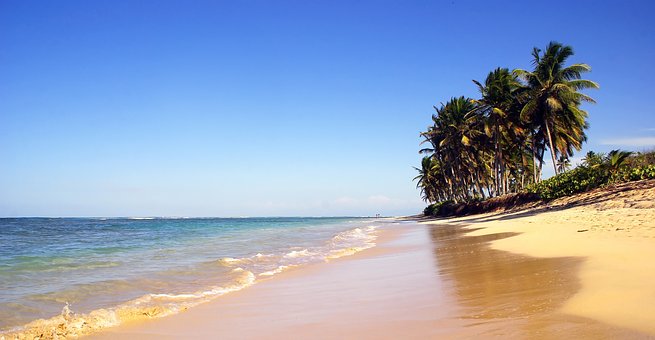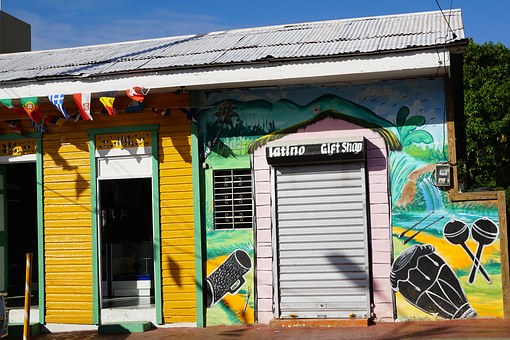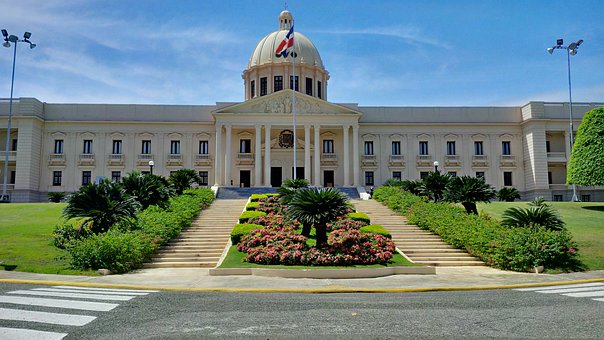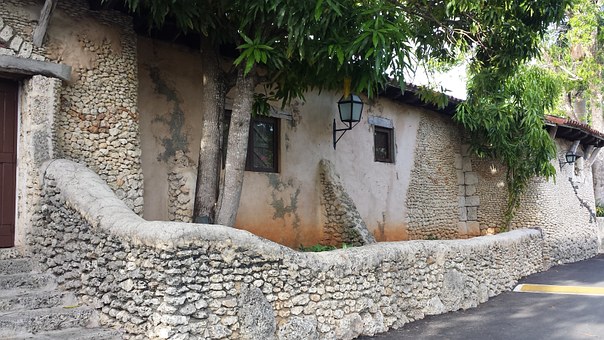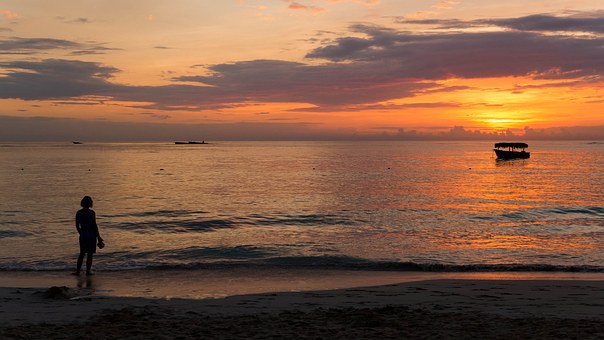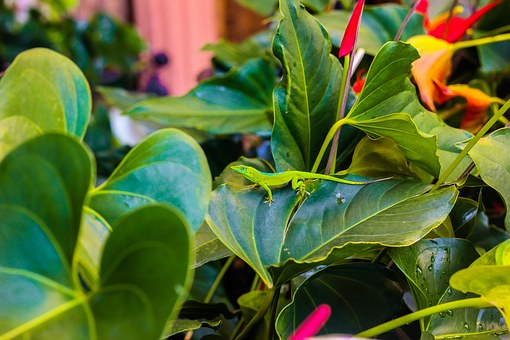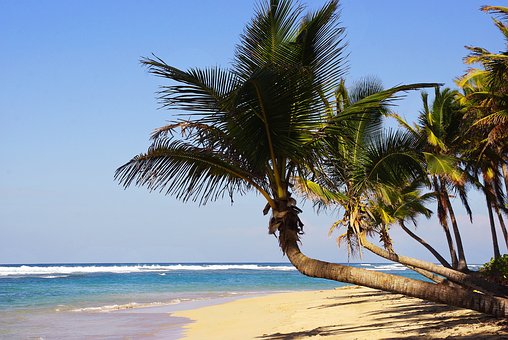Backpacking in Dominican Republic
On the island of Hispaniola, which belongs to the Great Antilles in the Caribbean, lies the Dominican Republic and occupies the east as well as the center of the island. In the western part of the island lies Haiti. When travelling in the Dominican Republic, you will encounter a diverse landscape characterised by high mountains, charming cities such as the capital Santo Domingo and endless white beaches with crystal clear waters.
The capital Santo Domingo is located on the southern coast of the Dominican Republic. With about 3 million inhabitants it is a big city, where you can still find the Caribbean small town flair. The city centre is characterized by historical buildings, small shops and countless street food stands. In combination with the relaxed atmosphere, you get the feeling of being in a small fishing village.
There are many different activities that you can experience on your backpacker trip in the Dominican Republic. In addition to hiking and sightseeing, the beaches offer many opportunities for diving, surfing and kitesurfing. In the last few years the country has developed into an agile party center, where not only in the different clubs, but also on the beaches there is a lot of partying.
The Dominican Republic has a good transport infrastructure, which gives you a good chance to get to know the country and its culture. Besides fabulous landscapes and unique beaches, there are relics from the early colonial period. A UNESCO World Heritage Site is the colonial city of Santo Domingo. However, there are other places of interest like the old town of Azua de Compostela and Monte Cristi that you should not miss during your backpacking trip.
The Dominican Republic is a relatively safe travel destination. The national language is Spanish. However, English is spoken on the island of Samaná. Money is conveniently available at the various ATMs. It makes sense to carry a credit card with you, as EC cards are not accepted everywhere. The payment is made in the local currency Dominican Peso (DOP).
Culture in the Dominican Republic
The cultural heritage of the Dominicans is very complex and consists of mixed traditions. There are influences of Arawak as well as French, Spanish and African culture, history and language. The independence of the Dominican Republic, proclaimed before the abolition of slavery, makes this island a unique place in the Caribbean. Additional cultural influences come from the USA and neighboring Haiti.
In addition to many old traditions such as cock fights, there is the modern American lifestyle on the other hand. This is reflected in the language. Because Spanish is Anglicised. It is dressed like US-Americans. The influences of American culture can also be felt in music, where a mixture of merengue and house or hip hop was born in the 1990s. Traditional elements are combined with modern ones.
More Backpacking Information for the Dominican Republic
On your backpacker trip in the Dominican Republic you will make a good living with 30 – 60 Euro per day.
In addition to indescribable beaches of white sand, palm trees and crystal-clear water, you’ll find an interesting mix of historical and modern, so you’ll embark on a voyage of discovery between ancient traditions and new influences. This special symbiosis makes the versatile island in the Caribbean a very special place.
There are many ways to find accommodation in the Dominican Republic. A room in a hotel is available from 23 Euros. If you are looking for real bargains, you will find a place to sleep between 10 and 14 euros.
The island is a true land of milk and honey with tropical delicacies. The influences of Spanish, international and Indian cuisine give the dishes their unique flavour. In addition to sun-drenched sweet fruits such as papaya and pineapple, the biggest temptation comes from the sea rich in fish, where lobsters, squid and king prawns are also at home.
As a German citizen you don’t have to worry about a visa as you can enter the Dominican Republic for 90 days without a visa. You can find out what else is important for you as a backpacker under Visa & Vaccinations.
Backpacker Budget in Dominican Republic
Travelling in the Dominican Republic is extremely pleasant due to the very good transport infrastructure. There are eight airports, of which only four are served by German airlines. The best way to get around the island is by bus. There are around 20,000 buses in the well-developed bus network, which will take you to even the most remote corners of the island.
When planning your budget, you can assume that you will need between 30 and 60 Euros per day. For a meal in tourist restaurants, so-called comedores, you pay from 4 to 5 euros for a meal. If you want luxurious food, the prices are of course much higher. You can get local beer for around 2 euros. Coffee and water cost 1 Euro. A delicious Caribbean rum with cola is already available for 2 Euro.
Taxi driving Bus driving in the Dominican Republic
Travelling by bus in the Dominican Republic is very pleasant and inexpensive, especially if you want to cover a longer distance. A one-way trip from Santo Domingo to Puerto Plata or to Samaná costs around 6.50 euros. Within the cities and between small towns you can drive very comfortably with mini vans. Alternatively, there are also shared taxis, the so-called Carritos, where a single trip costs 0.50 euros.
A good and cheap way to explore the city and its surroundings is to take a taxi, which is generally not expensive. Usually you pay between 4 and 6 Euros (200 to 300 DOP) for a ride. But be careful: the taxi drivers will certainly offer you a higher price. Motor taxis, moto for short, transport you for 1 to 2 Euro (50 to 100 DOP). The best thing to do is to agree the price with the driver in advance so that no nasty surprise awaits you in the end.
Buses in the Dominican Republic
Buses in the Dominican Republic run according to fixed timetables that are posted at the bus stations. If you want to get off, just tell the driver. Public buses are often very crowded and not very comfortable. But if you want a bit more luxurious travel, private bus companies and long-distance buses are the right choice. They start from the terminals in the cities. On board there are comfortable seats, a snack bar and of course an on-board toilet. However, the spirited driving style of the bus drivers takes some getting used to and is not for the faint hearted. One of the most famous bus companies is Caribe Tours, where you can book online on the website in advance.
Guaguas travel in the Dominican Republic
At first the transport system may seem confusing and frightening to you. But it’s really fun once you’ve seen through the system. The vehicles range from small buses to cars that transport you between the cities without a timetable during your backpacker trip. There are no stops, but occasionally start points and end stations. So that the driver will be aware of you, you simply wave to be picked up everywhere on the route.
Guaguas are not very comfortable and often overcrowded. Therefore it can happen to you that your backpacks are charged as an additional passenger, especially if there is no trunk available. On a distance of 100 kilometres you pay only 2 Euro (100 DOP).
Rail travel and domestic fares in the Dominican Republic
There are no train connections for passenger transport. However, there are interesting flights flying to and from Punta Cana, Santiago and Puerto Plata. The Dominican airline “Tropical Aero Services (TAS)” flies Fridays and Saturdays. The airline flies with small propeller-driven aircraft. The airline is certified for commercial commercial aircraft. The pilots and maintenance technicians are certified so that you can fly safely on your backpacker trip.
Backpacker Route in Dominican Republic
During your backpacker trip in the Dominican Republic you will encounter a cultural and multifaceted landscape that is guaranteed to leave a lasting impression. The country covers an area of 48,440 km² and is slightly larger than Switzerland. The interior of the country is dominated by mountain ranges and valleys of the Cordilleras, which run from northwest to southeast.
In the south they pour into the offshore coastal plain. The highest mountain is the Pico Duarte with 3175 m height. The island is crossed by numerous rivers. In the east you come across the Rio Yuna and in the north the Rio Yaque del Norte. The largest natural lake in the Dominican Republic is Lago Enriquillo. It is located near the border to Haiti. With the fascination that the island radiates, the question quickly arises what you should absolutely have seen on your backpacker trip.
Route 1: The classic (15-20 days)
- 3 days Santa Domingo to explore the capital of the country. Pure shopping is the order of the day!
- 2 days San Pedro de Macorís, visit Catedral San Perdo Apóstol and enjoy the beach.
- 2 days roaming Parque Nocional Del Este.
- Enjoy 2 days Punta Cana beach and sun and discover the Dominican lifestyle.
- 2 days on the peninsula Samaná, Las Galeras, Playa Ricon & Fronton and Las Terrenas.
- 2 days exploring Cabarete and relaxing on the beach.
- 2 days visiting Santiago de los Caballeros and Cap Haitien (Citadelle Laferriére).
- 2 days Jarabacoa. Experience indescribable landscape and impressive waterfalls.
- 2 days hiking through Constanza and the surrounding mountains.
- 1 day Santo Domingo shopping tour and nightlife.
Route 2: Backpacker Intensive Trip (up to 40 days and more)
- 3 days Santa Domingo to explore the capital of the country. Pure shopping is the order of the day!
- 2 days San Pedro de Macorís, visit Catedral San Perdo Apóstol and enjoy the beach.
- 3 days roaming Parque Nocional Del Este.
- 2 days Punta Cana beach, sun and enjoy the Dominican lifestyle.
- 4 Days Samaná, Las Galeras, Playa Ricon & Fronton and Las Terrenas
- 2 days exploring Cabarete and relaxing on the beach.
- Experience 3 days of Monte Christi and Parque National Monte Christi.
- 2 days visiting Santiago de los Caballeros and Cap Haitien (Citadelle Laferriére).
- 2 days Jarabacoa. Experience indescribable landscape and impressive waterfalls.
- 2 days hiking through Constanza and the surrounding mountains.
- 3 days San Juan de la Maguana and hiking tour to the Pico Duarte.
- Experience 4 days Lago Enriquillo and the Parque Nacional Sierra De Baoruco.
- 3 days Barahona. Enjoy beautiful beaches and unique nature.
- 3 days San Christóbal. Discover wonderful beaches and unique monuments.
- 2 days of Santo Domingo Shopping and nightlife.
Travel Times in the Dominican Republic
Climatically, a subtropical climate with high temperatures and high humidity awaits you during backpacking in the Dominican Republic. Just as typical in the rainy season are the heavy rainfalls. However, it never gets really cold.
The different climate zones also influence the travel times. If your destination is the north of the Dominican Republic, you should plan your trip from May to October. Although it is very hot during this period, you will not be hit by heavy rainfall.
In the south of the island the best time to travel is between November and April. If you want to go to Punta Cana in the east, it is best to travel from December to July. During the summer months the average temperature is 28° C. The winter is somewhat cooler with 16° C. Depending on the season, humidity can be as high as 84 percent. If you are able to cope physically with these conditions, you don’t have to make any compromises during the travel season.
It is important to note that from June to November there is a hurricane season in the Caribbean. The highest probability for a tropical cyclone is in September and October. More often you will experience heavy rainfalls, storms and strong winds. You will be able to protect yourself perfectly against them with suitable clothing in your luggage.
Backpacker accommodations in Dominican Republic
Backpacking in the Dominican Republic gives you many opportunities to travel and find suitable accommodation. Depending on which type of accommodation you choose, you will soon find that the costs vary greatly. The prices for a bed in a simple hostel are very similar to those in Germany.
But there are also unique alternatives that you can use. In a luxury hotel with all-round service, for example in Santo Domingo, you can easily pay 120 euros for an overnight stay. Directly at the beach, in a 5 star hotel you pay from 160 Euro. There are no upper limits.
You will be offered pure luxury, WLAN, TV and wellness program included. To keep the prices for an overnight stay manageable, take a look at the Hostelworld hostel page. So the question of how much an overnight stay costs for backpacking in the Dominican Republic is quickly answered. Thus, the prices for a bed in the hostel are as follows:
- Santo Domingo 10 -13 Euro
- Punta Cana 5 -22 Euro
- Cabarete 11 Euro
- Puerto Plata 12 Euro
- Las Terrenas 18 Euro
- Sosua 28 Euro
- Santiago 9 -28 Euro
Hostel prices can vary considerably from city to city. These price differences result from the design of the individual hostels, which are either very simple or much more comfortable.
Motels on exit roads and motorways
Besides the big resorts and the famous luxury hotels in the cities there is the possibility to stay overnight in motels, even if you are not travelling by car. The few are located at the entry and exit roads, mostly a little remote from the city centre, but easily accessible. The different hotels in the city centres are also interesting. The rooms have their own bathroom and offer a TV and WLAN. The prices are also very different here. From around 35 euros you can already get a double room.
Camping on the beach and in the country
As you know campsites from Germany and other European countries, there are no campsites in the Dominican Republic. “You should also consider “wild camping” carefully. However, you can pitch your tent on a private property if you ask the owners politely.
During the holiday season, many Dominicans camp on the beaches of the Samaná peninsula because the existing hotels are fully booked. If you want to camp on the peninsula, you should pitch your tent in Las Terrenas near Pino de Austria, in Las Galeras in El Cabito and in El Limon near Maria and Josef.
In each small village and also in the inland there are usually so-called Cabanas. They are often used by couples of lovers. They are partly very clean, so that you can spend a good night there. These cabanas are characterized by a good price for an overnight stay.
Backpacker Trips & Tips in Dominican Republic
Travelling the country is one thing, immersing oneself in culture and experiencing the mentality is another. It soon becomes clear that the Dominicans are not very open-minded towards tourists and see them as a good source of income. The locals often give the impression that they are bitter. As a backpacker from Germany you are often mistaken for Americans.
Especially noticeable are the constant attempts of the locals to offer any products and services. These are completely overpriced. So it can happen to you that you pay for example for the photo of a monkey the owner about 17 euros. But you shouldn’t be deterred by the obtrusive selling and begging Dominicans when backpacking in the Dominican Republic, but rather see it as an exciting challenge.
Backpacker Highlights in Dominican Republic
Anyone can spend a beach holiday in the Dominican Republic. But you can only experience the uniqueness of the island in all its facets if you get involved with the many things the island has to offer. Besides a visit to a cocoa plantation and a snorkeling tour to the overcrowded Bacardi Island, the highest mountain of the Caribbean, the jungle and the steppe and backpacker highlights you should not miss.
Shopping in the Dominican Republic offers much more than just rum and cigars. There are a lot of souvenirs like clothes, art and jewellery at reasonable prices. In addition to small shops, you will find large shopping centers located in the major cities. In Santo Domingo, there is a bustling downtown area around Calle del Sol where you can shop, eat, drink and enjoy an extensive nightlife.
Backpacker Insider Tips in the Dominican Republic
A fantastic trip awaits you on a tour on Lake Enriquillo, which starts from a small ranger station. The salty lake is 40 metres below sea level. There is an indescribable fauna to admire. Because here live beside a multiplicity of iguanas also crocodiles, which cavort in the water. On the small island Cabritos there are cave paintings of the Tainos and flamingos to admire.
Not only Punta Cana is the first port of call for a beach holiday. At the north coast there are countless dream beaches, which are considered as Backpacker insider tip. Especially attractive are the bay of Dosua and Playa Grande, which are close to Puerto Plata and Sosua. At Playa Cabarete you can enjoy life on a natural beach while chilling, eating, drinking, bathing and sunbathing without mass tourism. Sports activities such as beach volleyball and kitesurfing are included.
Food & Drinks in Dominican Republic
As diverse as the island’s culture is, as diverse is the cuisine you’ll find on your backpacking trip to the Dominican Republic. As on all islands of the Caribbean, history influences Dominican cuisine. The Africans brought the unique art of processing coconuts with them. You can find it mainly on the peninsula Samaná.
In the cuisine of the Dominican Republic you will experience influences from French, Swiss, Swabian and Chinese cuisine. Everywhere in the cities and larger localities there are comedores, small local restaurants and snack stalls, which invite to the lunch table (almuerzo). Ordering is very advantageous for those who don’t know languages, as the dishes are lined up in large showcases on hot plates to choose from.
Food in the Dominican Republic
The food always looks very appetizing. But if you are not sure, you should ask. The delicacies can also turn out to be fried innards “asaduras” or tripe soup “mondongo”. The hearty dishes of Dominican cuisine are not necessarily to everyone’s taste, but definitely worth a try.
Almost always you will find delicious dishes in the showcases of the comedores or in the few restaurants with local cuisine, which are called cocina típica. So you get tasty specialties like bacalao, a strongly spiced ragout from braised stockfish as well as the delicious stew sancocho de pescado with fish or sancocho de res with beef.
The way soups are prepared comes from Spain. The ingredients such as yam root, corn and manioc belong to the cuisine of the local taíno. On your culinary journey, the national dish bandera dominicana should not be missing. It consists of red beans, white rice and meat with spices that are cooked together.
Drinks in the Dominican Republic
If you like beer, you’ve come to the right place in the Dominican Republic. Because special beer specialities are waiting for you. Presidente”, one of the best-known beers along with Bohemia, will be served as a present. Presidente is available in 365 ml, 650 ml and in jumbo bottles with 1 l capacity. The beer is drunk ice-cold.
The national drink of the Dominicans is the local rum, which is made from cane sugar. The locals usually drink it pure. The best known varieties are Brugal, Bermúdez and Barceló. The best rum is the Añejo, which matures the longest in high-quality wooden barrels. The genuine Caribbean rum from the Dominican Republic is an 80 percent distillate to which only a little water is added to reach a drinking strength of 38 – 54 percent.
On your backpacker journey, don’t miss out on the delicious cocktails and long drinks with rum. The best known are Cuba Libre and Pina Colada. But you can also find other cocktails on the drinks menus, which simply taste delicious and make you want more.
Besides alcoholic drinks there are also tasty drinks without alcohol. These are the delicious fruit juices like china, guinea, lechosa and toronja, where freshly squeezed orange juice, banana juice, papaya juice or grapefruit juice are combined with milk or water.
Backpacker Visa und Impfungen in der Dominikanischen Republik
During your backpacker trip to the Dominican Republic you don’t need a visa, because as a German citizen you can enter the country without a visa for 90 days. However, you need valid entry documents. The entry regulations according to the Foreign Office are as follows:
- Passport: Yes
- Provisional passport: Yes
- Identity card: No
- Temporary identity card: No
- Passport for children: Yes, with photograph
Annotations
Children’s entries in a parent’s passport are no longer valid. All children need their own identity card to enter the Dominican Republic. When entering the Dominican Republic, a tourist card must be purchased for 10 euros. It is valid for 30 days.
Medical Information & Vaccinations for the Dominican Republic
For a stay in the Dominican Republic it is recommended to have the standard vaccinations of the Robert Koch Institute up to date. In addition, you can be vaccinated against hepatitis B, typhoid fever and cholera. The medical care offered in the big cities is on a Western European level.

